Steph W. from SEOPressor


...help you check your website and tell you exactly how to rank higher?


93
score %
SEO Score

Found us from search engine?
We rank high, you can too.
SEOPressor helps you to optimize your on-page SEO for higher & improved search ranking.
By jiathong on September 13, 2019
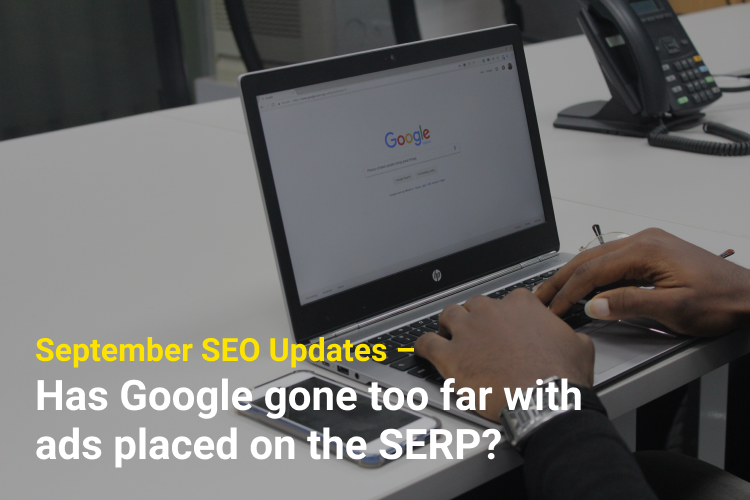
Welcome to a new month! Hope you’ve been enjoying our weekly updates and would look to hear your thoughts on the series so far. Leave us a message below even if it’s just a HELLO!
Now let’s jump right in to see what’s happening in the SEO industry this week.
SEO expert Mary Haynes observed a spike in organic traffic for sites that have previously disavowed bad links following the team’s suggestion. While the opposite happens to some of the sites who did not follow through with the same advice.
Though it is still too early to be sure, the team advise webmasters to review their backlink profile and disavow any bad links in the case that organic traffic starts dropping last week.
They recall that John Mueller from Google affirms the usefulness of disavowing bad links and maintaining a clean and organic backlink profile earlier this year.
To quote Mueller: “So it’s something where our algorithms when we look at it and they see, oh, there are a bunch of really bad links here. Then maybe they’ll be a bit more cautious with regards to the links in general for the website. So if you clean that up, then the algorithms look at it and say, oh, there’s– there’s kind of– it’s OK. It’s not bad.”
Review rich results can be extremely helpful when searching for products or services. They’re the snippets you see that have stars in them, which acts as its rating score (Just like the one below).

Google announced that they are introducing algorithmic updates to reviews in rich results. In this update, Google limits the pool of schema types that may trigger review rich results in search.
Google will only display reviews with these types of schema and their respective subtypes:
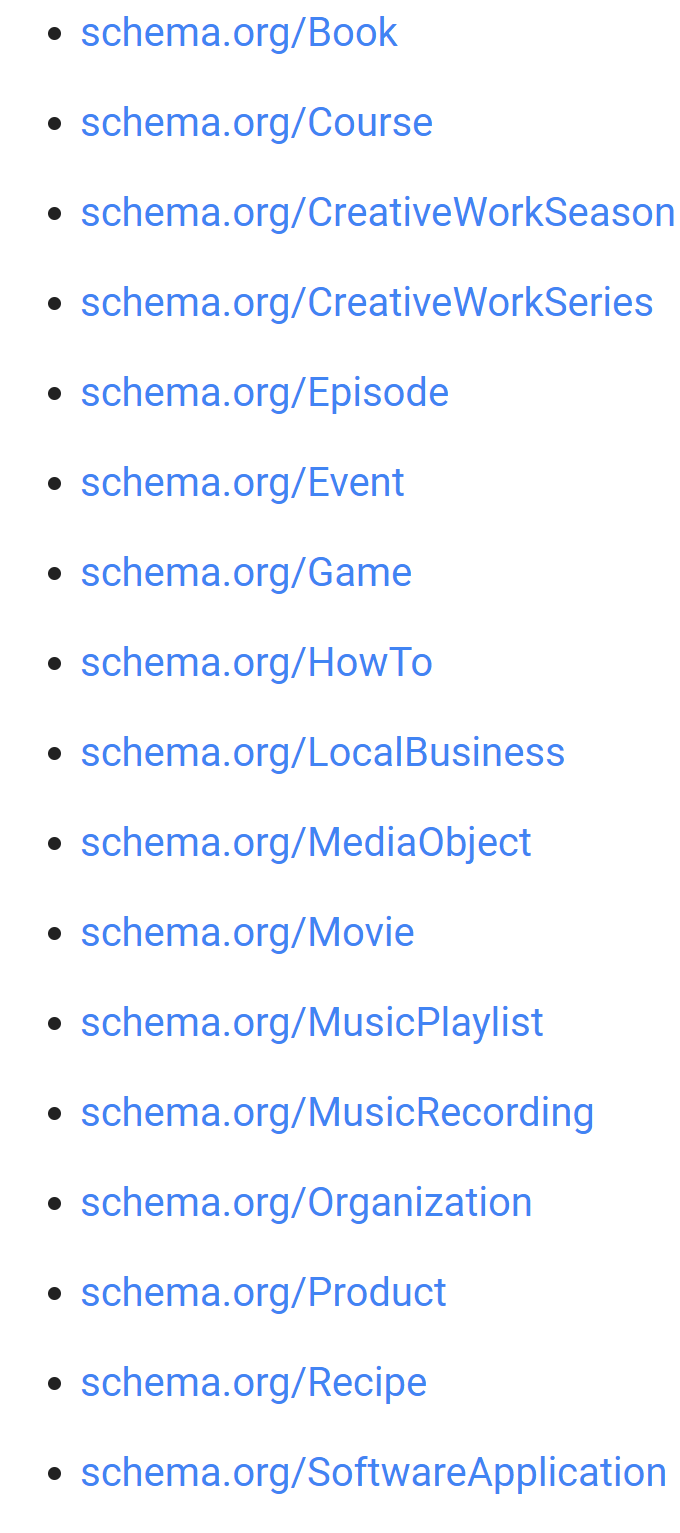
Google will also not display any reviews that are perceived as “self-serving” as they aren’t in the best interest of users. Technically, users can use 3rd party widgets to add review markup about themselves on their home page and cause the review snippet to show for that page.
2 days later, Google has added some frequently asked question to that blog post. Check them out in the image below:

So, don’t worry. You do not need to remove your old reviews and there are also no manual actions for this. If you’d like to read more on Google’s structured data guidelines, visit: Follow the structured data guidelines.
Overall, I think that this algorithmic update would help provide a better experience for the users, as users get to read authentic reviews.
**Update 19/09/19- Not more than 3 days after the algorithm roll-out, @brodieseo spotted that the number of snippets with reviews has gone down. We believe this will go on for some time.
Alright, safe to say this is continuing. Seeing a further drop of ~2 points. Again, not able to see massive changes in the SERPs yet. A good one to check is "SEO [City Name]", there will be a noticeable change there. This is now a total drop of ~7 points since announcement. https://t.co/SQ2qfAE6qN pic.twitter.com/WdNEvgdrFC
— Brodie Clark (@brodieseo) September 18, 2019
Like promised, Google pre-announced another algorithm update, this time called the September 2019 Core Update on their Search Liaison Twitter account on the 24th.
Later today, we are releasing a broad core algorithm update, as we do several times per year. It is called the September 2019 Core Update. Our guidance about such updates remains as we’ve covered before. Please see this blog for more about that: https://t.co/e5ZQUAlt0G
— Google SearchLiaison (@searchliaison) September 24, 2019
The update was officialled rolled out on the next day, Sep 25th. But webmasters are having a hard time trying to pinpoint which are this update is targeting.
Google remains as tightlipped and cryptic as usual, referring concerned SEOs to an old guide . Which puts spotlights on the quality of content, and getting yourself familliar with the quality rater guidelines & E-A-T.
Noticed any volatility in your websites? Comment below and let us know!
Google has updated the Google Search Quality Rater Guideline handbook on September 5th – that is four months after it has last updated the guidelines on May 16, 2019.
The live guideline document is now one page thicker than last time at 167 pages, and you can read the full document here.
But long things short – here’s everything you need to know about the changes in Google Search Quality Rater Guidelines updates:
In several places, the QRG has changed to emphasize the importance of having original content.
This correlates with one of Amit Singhal’s 23 questions on Google Webmaster that concerns a site’s quality, which is:
Does the article provide original content or information, original reporting, original research or original analysis?

In the “Very High-Quality Main Content” section, it reads:

Currently, a search query of “natural cancer cures food” displays different results on Google whereby Google search shows trusted websites like Healthline and WebMD while the same query on image search shows more alternative health websites.
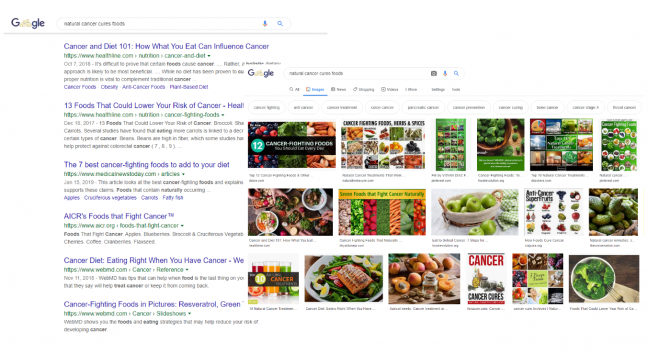
Based on this update, it would seem that moving forward that Google will most likely start applying E-A-T (Expertise, Authority, and Trustworthiness) filters to an image search for YMYL queries.
Google also made a few clarifications on YMYL pages, describing them as “type of pages or topics that could potentially impact a person’s future happiness, health, financial stability or safety.”
There’s also differences in terms of YMYL examples and one important info for shopping/ transactional websites:

This statement may possibly show that Google will put more emphasis on reviews that come from actual users of your products.
BIG News. Google yesterday has revealed two new link attributes – rel=”sponsored” and rel=”ugc” in addition to the rel=”nofollow” link that was introduced in 2005.
Here’s the description for each link attribute:
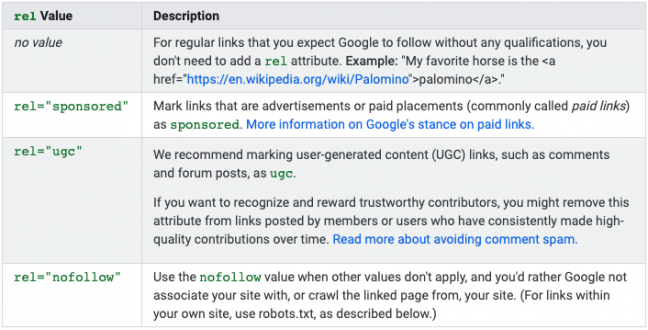
Basically, the two new link attributes serve further clarity to the rel=”nofollow” link attribute that lets Google identify if the content is a paid placement or user-generated content. But what, we SEOs don’t understand is why?
More specifically, we don’t understand what are the incentives for making these changes in the site, and it most certainly did not help when Danny Sullivan added that it is perfectly fine to leave your nofollowed links as they are and just ignore the two new options.
https://twitter.com/AlanBleiweiss/status/1171482479254884354
So, in most cases, nothing has changed. Still, SEOs speculates that the most important part of the whole announcement is not adding the new link attributes but that Google is treating rel=”nofollow” as a hint now, which might be taken into consideration.
Webmasters had the control to prevent Google from showing their webpages as a snippet, now Google is going one step further and providing webmasters more options to control how they want to show their snippets.
Google announced a new set of meta tags and HTML attributes which includes.
These controls will go live on mid-end of October.
John Mueller from Google touched on the topic of M-DOT sites on this week’s Google webmaster hangout video.
He phrased it as an “unstable situation” where sites having mobile-first indexing may be shown their M-DOT site, even when the search is done on desktop and not mobile.
To fix that, Mueller suggests redirecting desktop users to the correct desktop site, so Google can better understand the situation in the case they didn’t catch it at first.
At the end of the day, Google still recommends adopting responsive design to handle desktop and mobile users.
Here’s the video of Mueller discussing the issue.
Visuals and textual information are easy to interpret and skim. On the other hand, videos aren’t skimmable like them. Google has introduced a new SERP feature that allows users to find key moments within videos, which makes the information-seeking process quicker.
When you search for things like how-to videos, there will be many steps. The new feature provides links to a specific part of the video. This is made possible with the help from content creators. The links are based on timestamps provided by them.
This is how a video will appear in Search if a timestamp has been added by its creator.
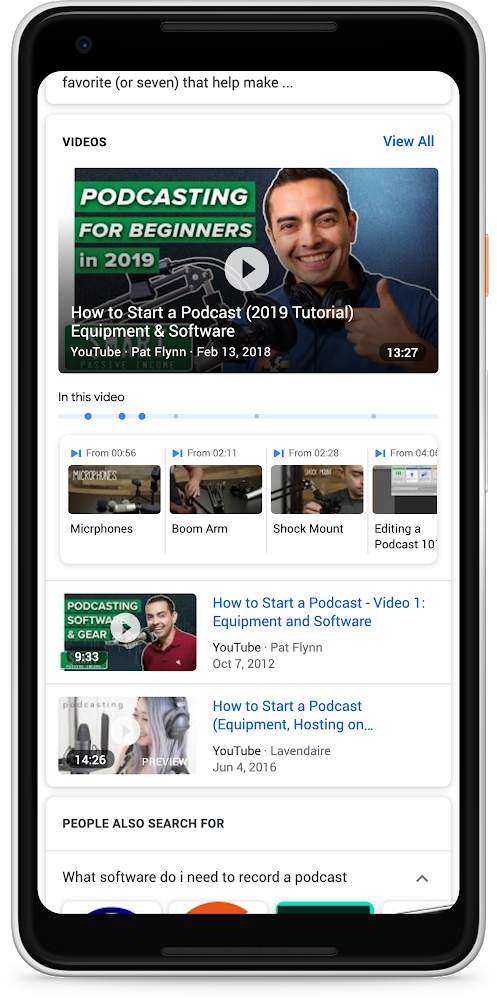
If you want Google Search to be an entry point for discovering and watching videos, you need to mark up your video content with structured data. Google has a developer’s doc that teaches how you can mark up, learn it here.
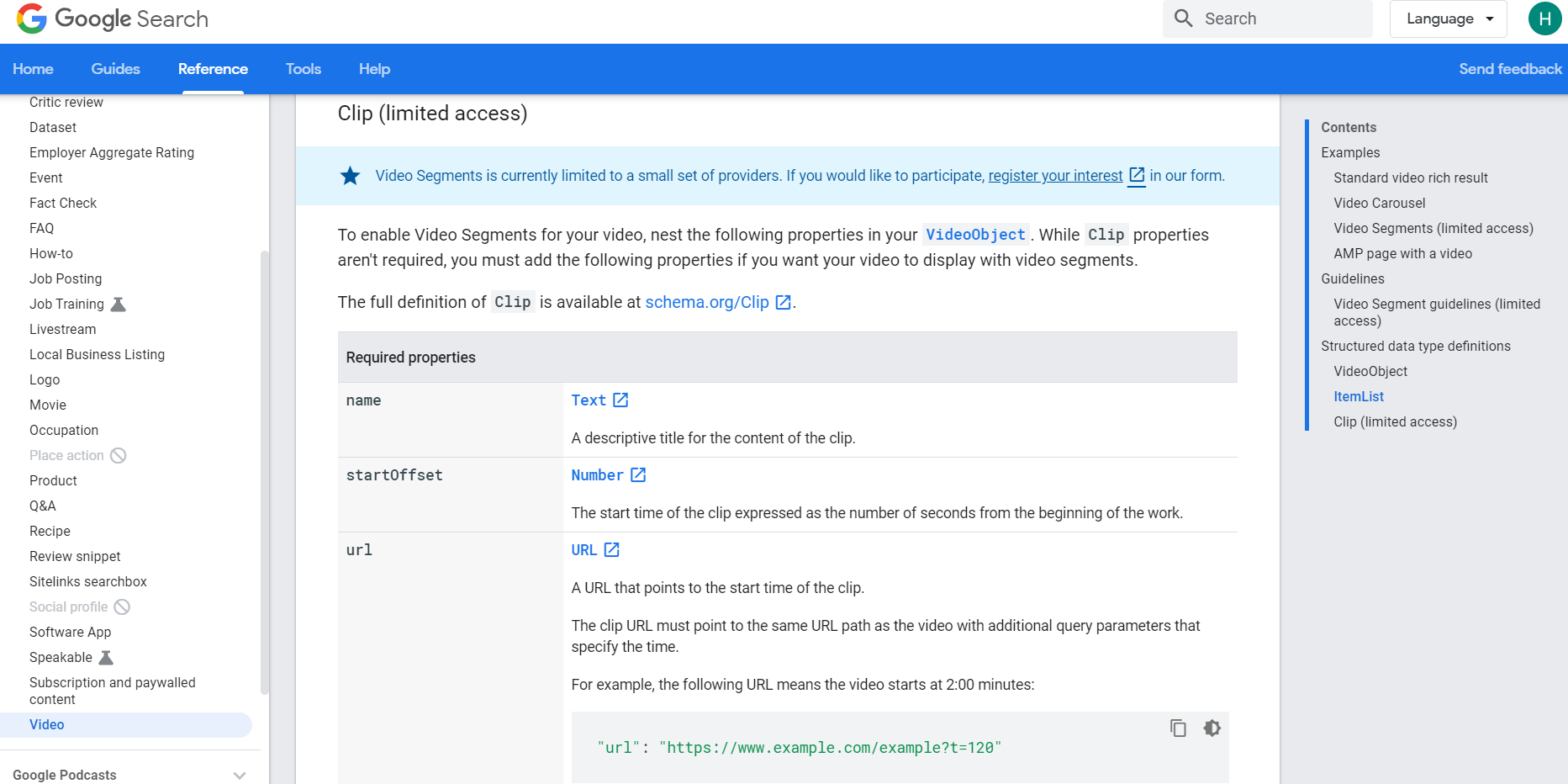
Google is showing emojis everywhere. You read that right, showing emojis everywhere! I don’t think I’ve seen the emojis appearing in the SERP before.
Emojis appeared in autocomplete.
Is this something Google is testing .@rustybrick .@dannysullivan? I've never seen an emoji in a suggested search before 🧐 pic.twitter.com/XzfluUXxJd
— Brian Freiesleben (@type_SEO) September 17, 2019
I’ve even done a search using an emoji. Here’s the result:
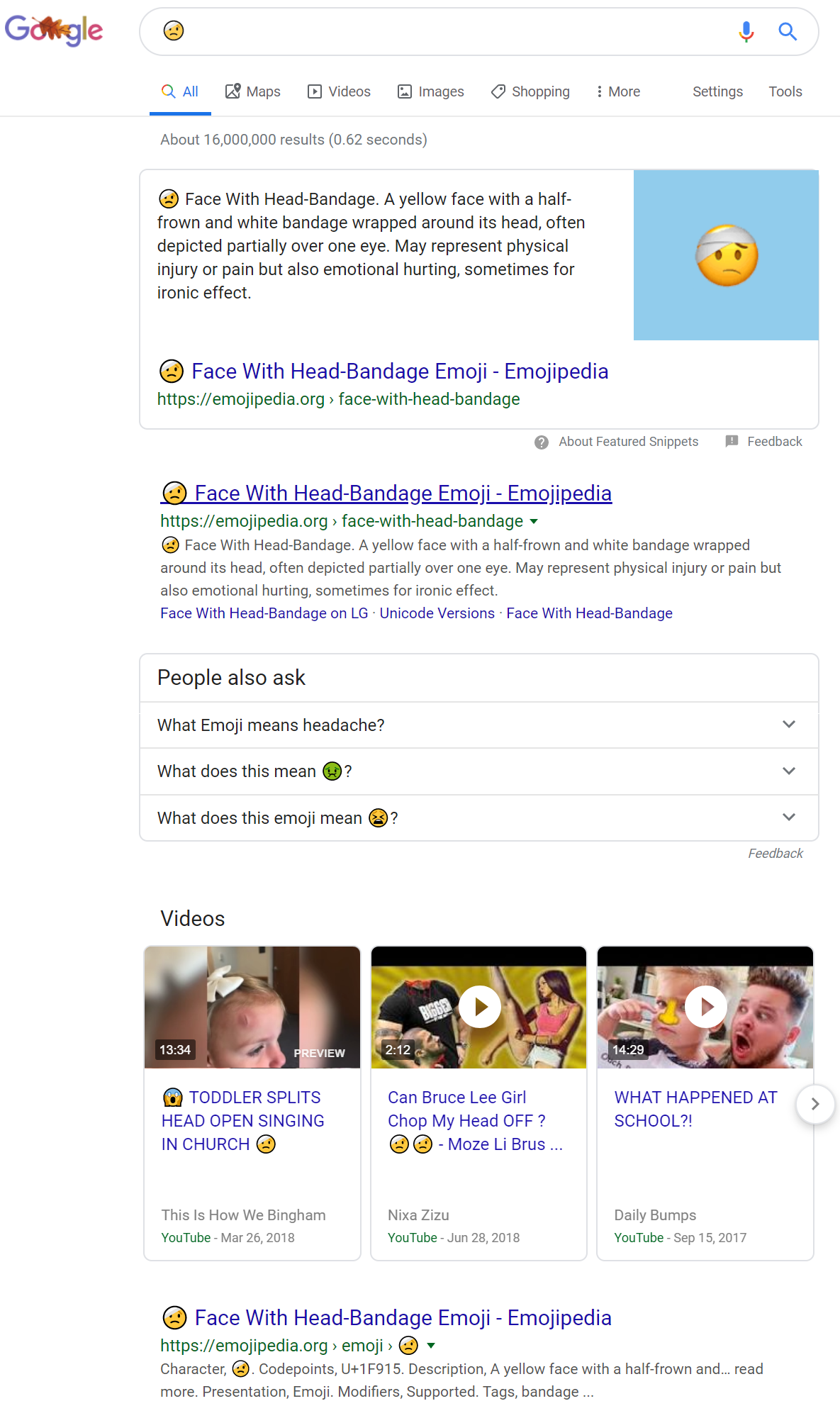
As you can see, there’s emoji in snippets, ‘people also ask’, as well as videos.
Is this new or am I just outdated? Let me know.
Here’s something you might not know about the Knowledge Panel’s ‘Did you know:’. It provides you with new facts if you refresh the page. But, it does not happen every single time you search. Here are some screenshots. Click to enlarge.
Also, if you noticed, you will see that each fact has a different citation. A great way perhaps to boost your visibility?
SEO Gianluca Fiorelli (@gfiorelli1) posted a peculiar SERP featured that he spotted.

Here’s the screenshot of the automatically-translated panel. courtesy of @gfiorelli1
While doing a search in Italian, Google returns a SERP with the the top ranked result a Wikipedia page in English, and simultaneously pulled a knowledge panel from that same Wikipedia page, but translated into Italian.
Pretty cool right? Though I can’t judge the accurancy of the translation, being not knowing a single word of Italian, this seems like a good feature that can push your content to audiences out of your targeted country.
Have you seen results like this before as well? It’s definitely a first time for me.
Previously, business owners can set a service area based on a distance around their physical location. But now, Google is retiring that option and business owners will have to choose a closest named area instead.
Listings still using the distance-based service area will be automatically converted to the closest named areas.
The move of retiring the distance-based area was started since last November, so business owners are actually given ample time to edit and update their GMB listing.
Nevertheless, Google will be sending out notification emails about the change.
Base Camp CEO Jason Fried tweeted his dismay on having to compete for his own company name for SERP real estate.
Making users scroll through not one not two but four paid ads before getting to the company website they are specifically searching for is probably stretching the term – efficient user experience.
Though we understand that such ads are handled by the GoogleAds team, it’s still disheartening seeing companies having to compete for their own brand name. Though easily solved with some dollar bills.
To provide users with the most relevant ads, we don’t restrict trademarked terms as keywords. We do restrict trademarked terms in ad text if the trademark owner files a complaint here: https://t.co/J1P7oJ5BTN
— Google Ads (@GoogleAds) September 4, 2019
The GoogleAds team did try to offer an olive branch, but it only fuels more witty pokes from the enraged.
How generous of you to let us manually flag trademark violations! We'd hate to be burdened with the automated system you use to protect your own trademarks. pic.twitter.com/AoWzbgthX4
— Adam Stoddard (@AdamStddrd) September 4, 2019
Fair game the big G said.
New structured data incoming! Google is constantly pushing for the implementation of structured data and also keen on providing tools and new markups to help webmasters to get a little bit more edge in the SERP.
They announced the new markup via Twitter, check out the documentation here if you’re interested.
📽"You can't handle the markup!"🍿There's new structured data documentation for Movie carousels 🎬: https://t.co/JU6iGtPi5x
— Google Webmasters (@googlewmc) September 5, 2019
John Mueller from Google stated through a couple tweets that no, when someone else took your image and embed it on their site (also called hotlinked), that does not count as a backlink.
Do you need to disavow it? Or will that make your link profile look suspicious?
Not at all, John said you can simply ignore them and they will have no impact on your SEO whatsoever.
Users on the blogging platform Blogger has reported on their sites not being crawled nor indexed starting from as early as September 20th.
Google has been notified of the problem and has issued a fix around the 24th and said that crawling and indexing will return to normal in 48 hours.
SEO Aleyda Solis (@aleyda) tweeted a (somewhat hilarious) screenshot of her inbox where it’s being bombarded with warning from Google about her breadcrumb markups.
Thanks Google Search Console, I think I got your point 😁🙋🏻♀️😅 pic.twitter.com/xndAFcclWy
— Aleyda Solis (@aleyda) September 20, 2019
John Mueller chimmed in and said that since Google’s added the breadcrumb markup reports in Search Console, warnings are being fired out automatically.
Raise up your hand if you’re a victim of this inbox bombing too.
Updated: 11 December 2025


Save thousands of dollars (it’s 100x cheaper)

Zero risk of Google penalty (it’s Google-approved)

Boost your rankings (proven by case studies)
Rank High With This Link Strategy
Precise, Simplified, Fast Internal Linking.
